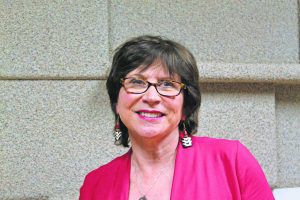Lea Kahn, Staff Writer
By Lea Kahn, Staff Writer, Sandra Lanman had a tree, but there was a problem. The tree was bare., The family tree, that is., But now, after two decades of cultivation, the tree is thriving., Lanman, who lives in East Brunswick Township, outlined the story behind her family tree – and how she filled the branches – to more than a dozen attendees at the Beth El Synagogue of East Windsor’s Genealogy Club., Lanman’s search for her ancestors began with her mother, Marion Buchwalter Hahn. Lanman’s mother was born in Germany in 1928, but was adopted by the Buchwalter family in 1932., Like many others, the Buchwalter family fled Germany in 1939 and settled in the Washington Heights section of New York City., Lanman’s mother married Ludwig Hahn, who was also a German Jewish refugee, in 1948. But it was not until 1950, when Lanman’s mother sought to become a naturalized United States citizen, that she learned that she had been adopted., “She didn’t know she was adopted. She found out later that she had been adopted. She wanted to know her origins,” Lanman said. But her mother was torn between wanting to know and not wanting to know because, like many adopted children, she feared that her biological mother would reject her again., Toward the end of her mother’s life, Lanman said, she tried to talk to her mother about the family, but her mother did not want to talk. Lanman’s mother died in 1991, but the urge to learn more about them lived on in Lanman., “My mother planted the seed in me to want to know who I am and where I came from. (But) I didn’t have the same emotional weight of rejection,” Lanman said. Her mother was born out of wedlock and given up for adoption., With some of her mother’s documents in hand, Lanman set about searching for her mother’s family and her father’s family, as well. Her father, Ludwig Hahn, was 15 years old when he was sent from Germany to live in England. His family stayed behind and died in the Holocaust. Hahn later settled in the United States., Wanting to know more about one’s family is not unusual, but finding out information on family members that exceeds a generation or two is challenging. It is even more challenging when adoptions are involved, as Lanman found out., Lanman told the attendees that she used the usual information sources – the Family History Center of the Church of the Latter Day Saints and U.S. government databases, such as the Social Security Death Index., Lanman also used www.Jewishgen.org, the U.S. Holocaust Museum and the Jewish Historical Society of Central Jersey., Google was yet another resource, Lanman said. Reaching out on the Internet led her to people she did not know, but who were interested in helping her search for her family., There are many reasons – besides curiosity – to search for information about one’s ancestors., “The way I look at family history, it gives you a sense of connection. We are waves on the oceans of history, and our lives flow with the current. It is history on a personal level,” Lanman said., Lanman pointed to her biological grandmother, who married Guenter Hamburger – not the man who was Marion Buchwalter Hahn’s biological father – in 1938. They fled Germany and spent World War II in The Philippines, under Japanese rule., Lanman’s biological grandmother was injured and her husband was killed in the battle to retake The Philippines in May 1945. She moved to the United States in 1946, remarried and died in 1995., But for some people who are interested in pursuing their family history, there are more pressing reasons to know more about it, Lanman said., “I learned too late how important it is to know the family health history,” Lanman said. Her daughter died of breast cancer, and it was later discovered that she had a genetic predisposition for breast cancer., While Lanman has uncovered much of her family’s history, her work is not finished. There are leaves on many branches of the family tree, but there are still a few more that need to be filled out.

